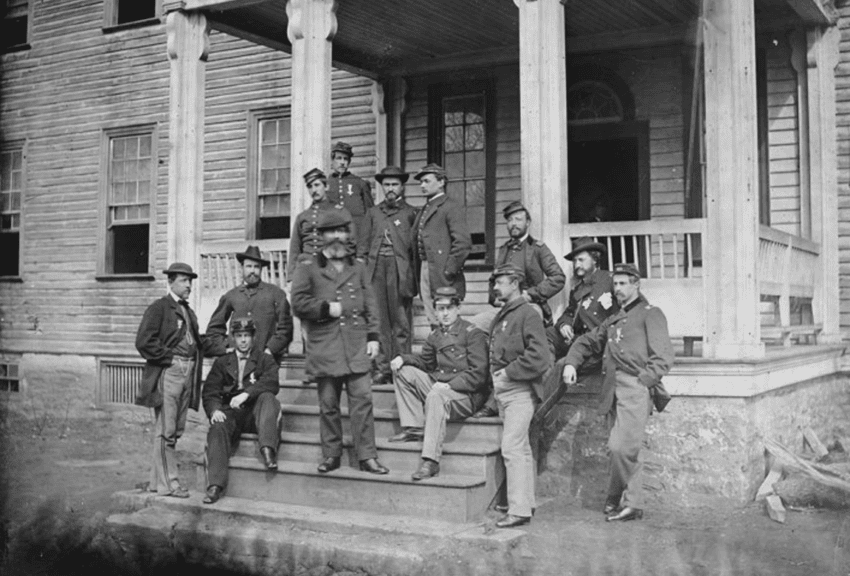May 1864
By Phil Kohn
Phil Kohn can be reached at USCW160@yahoo.com
Work begins on May 1, 1864, on “Bailey’s Dams” at Alexandria, Louisiana. The plan is to free the Union flotilla accompanying Maj. Gen. Nathaniel Banks’s Red River Campaign — stranded by very low water in the Red River — by floating the vessels over a series of rapids on waves of water released suddenly from the several dams. The idea was proposed by Lt. Col. Joseph Bailey, who had been trained in civil engineering. At Stone Church, Georgia, about 100 miles northwest of Atlanta, skirmishing occurs between the Union troops of Maj. Gen. William T. Sherman and the Confederates of Gen. Joseph Johnston.
In northern Virginia, there is a bit of contention in the command staff of the Army of the Potomac on May 3. While Maj. Gen. George Meade is the army’s commander, Lt. Gen. U.S. Grant, the head of the entire Union Army, is traveling with it. Grant wants to attack Robert E. Lee’s right flank, using the relatively easy access of water transportation on the Rapidan and Rappahannock Rivers thereby cutting off Lee’s force from Richmond. Meade, alternatively, wishes to attack Lee’s left flank, which would avoid the dangers of having to fight in Virginia’s Wilderness region. Execution of that plan would preclude Lee from further moves northward towards Washington. Not surprisingly, Grant prevails. In Arkansas, the Union force of Maj. Gen. Frederick Steele finally staggers back into Little Rock, ending its bungled attempt to reach and aid the failed Red River Campaign.
On May 4, 122,000 men of the Army of the Potomac cross the Rapidan River to face the 66,000 Confederates of Robert E. Lee’s Army of Northern Virginia. In Washington, D.C. the House of Representatives passes — over President Lincoln’s objections — the Wade-Davis Reconstruction Bill, which includes a number of harshly punitive measures against the South once the war ends. President Lincoln is hoping for a more-moderate Reconstruction plan. Also opposed to the House bill are extreme Radical Republicans, led by Rep. Thaddeus Stevens of Pennsylvania, who feel that the House bill is not punitive enough.
Once aware of the Army of the Potomac’s movement, Gen. Lee on May 5 moves his troops up quickly, catching the Union force in the thick, deep woods of Virginia’s Wilderness. A two-day battle at close quarters results, with a forest fire raging at the end of the second day. Union casualties number 17,666, including 200 wounded Federals consumed in the flames. Confederates lose about 7,500, including Lt. Gen. James Longstreet, seriously wounded by his own troops not five miles from where Stonewall Jackson suffered the same fate a year earlier during the Battle of Chancellorsville. Instead of retreating after the battle (as happened almost every time before), Grant this time orders the Union army — much to its surprise and satisfaction — to move east then south to turn Lee’s flank.
On May 7, Maj. Gen. William T. Sherman moves his 100,000 troops against 65,000 Confederates under Gen. Joseph Johnston at Dalton, Georgia. Over the next weeks, the two commanders will establish a pattern: Sherman will move to one flank of Johnston’s or the other, and Johnston will retreat to a new defensive position.
The Army of the Potomac reaches Spotsylvania Court House, Virginia, on May 8, but Lee’s troops have gotten there first. Fighting takes place here over the next 13 days, including particularly vicious attacks and counterattacks on May 12, at the so-called “Mule Shoe Salient” that becomes known as “The Bloody Angle.” Over the course of the Battle of Spotsylvania, the Union losses are around 17,500 of 110,000 engaged. The Confederates have about 50,000 engaged, but losses are unknown.
On May 9, at Alexandria, Louisiana, construction finishes on “Bailey’s Dams” and the first of Adm. Porter’s Union vessels, the timber-clad gunboat USS Lexington, successfully “shoots the wave” of water passing over the rapids when the dams’ gates are opened. The rest of the flotilla follows over the next four days. At Spotsylvania, Virginia, Union Maj. Gen. John Sedgwick, standing in the open, chastising his men for trying to dodge bullets being fired from distant woods, says: “They couldn’t hit an elephant from this dist . . .” He is shot below the left eye and mortally wounded before completing the sentence by a Confederate sharpshooter positioned over 1,000 yards away.
A Confederate corps (the Army of Mississippi), led by Lt. Gen. Leonidas Polk, begins moving from its base in Mississippi towards Georgia on May 10, to join with Gen. Joseph Johnston’s Army of Tennessee.
Confederate cavalry under Maj. Gen. J.E.B. “Jeb” Stuart on May 11 clashes with 13,000 Union cavalry being led on a raid by Maj. Gen. Philip Sheridan at Yellow Tavern, Virginia, north of Richmond. The Federals push the Southerners back; during the fierce fighting, Stuart is mortally wounded and dies the next day in the Virginia capital. The battle gives the Confederates time to shore up the defenses around Richmond, and Sheridan, realizing it would be unwise to move on the Confederate capital, heads southward to link up with Maj. Gen. Benjamin Butler.
Confederate troops from Richmond attack Sheridan’s cavalry, riding south toward Butler, on May 12. Meanwhile, Butler and his men begin moving toward Drewry’s Bluff, south of Richmond, which is being strengthened by Gen. Beauregard.
In New York City, on May 13, Horace Greeley writes in his Tribune newspaper: “Our own conviction is . . . that it is advisable for the Union Party to nominate for President [in the upcoming elections] some other among its able and true men than Mr. Lincoln.” In Georgia, Sherman draws Johnston out of Dalton on May 13 and forces a fight at Resaca. After two days, the Union troops are repulsed, but Sherman finds a way around Johnston’s flank. Johnston withdraws toward Calhoun and Adairsville, some six and 17 miles to the south, respectively.
On May 15, in Virginia’s Shenandoah Valley, a Union force of 6,500 led by Maj. Gen. Franz Sigel meets Confederate cavalry at New Market under Brig. Gen. John Imboden. Imboden’s troopers are joined by Maj. Gen. John Breckinridge and some 5,000 hastily gathered reinforcements, including 247 Virginia Military Institute cadets. Breckenridge attacks and Sigel is able to hold for a while, but by late afternoon is forced to retreat to Strasburg, leaving the Valley in Southern control. Casualties: U.S.: 831; C.S.: 577 (including 10 killed and 47 wounded among the VMI cadets).
After 11 days of feints, skirmishes and other actions that his men sarcastically term “stationary advances,” Union Maj. Gen. Benjamin Butler on May 16 finally engages half his 35,000-man Army of the James against Confederate Fort Darling, at Drewry’s Bluff, some 7 miles downriver from Richmond. An aggressive defense by Gen. Pierre Beauregard’s troops compels Butler to withdraw his force to a defensive position on the Bermuda Hundred peninsula, where it is promptly “bottled up” by the Confederates, foiling Gen. Grant’s plan for a two-pronged assault on the Confederate capital.
On May 18, Rome, Georgia, falls to William T. Sherman’s Federal troops.
In Louisiana, Federal troops and ships reach the Atchafalaya River on May 19, bringing an end to the ill-fated Red River Campaign led by Banks and Porter.
After Spotsylvania, Grant and Lee continue their pattern of action: Following an engagement, Grant sidles eastward and then southward, Lee beats him to the target point, and they engage again. On May 20, it’s at Hanover Station. On May 21, it’s at Guiney’s Station, then at the North Anna River (May 23-26), and then at Totopotomoy Creek (May 28-30).
On May 24, in Georgia, Johnston moves his Confederate force from Allatoona, 28 miles southeast of Adairsville, some 20 miles southwest to Dallas, roughly 32 miles from Atlanta, trying to stay in front of Sherman’s Union army.
Taking advantage of the U.S.’s preoccupation with its own Civil War, Maximilian von Habsburg — an Austrian supported by Napoleon III of France, the French Army and Mexican monarchists — lands at Veracruz, Mexico, on May 28, and declares himself Emperor Maximilian I of Mexico. He and his backers (including French troops) are opposed by supporters of ousted former Mexican president Benito Juárez. (The Mexican conflict ends in May 1866, when Maximilian is captured and subsequently executed. Four months earlier, in January 1866, Emperor Napoleon III of France — seeing that the war was unwinnable and citing the continuing financial drain — had ordered French troops to withdraw from Mexico, thereby undercutting Maximilian’s military support. With the fall of the Empire, Benito Juárez is returned as president to the “restored republic” of Mexico.)
By May 31, the battles in Georgia between the forces of Sherman and Johnston have resulted in about 9,000 casualties to each side. In Virginia, Grant shifts part of his lines toward Cold Harbor, northeast of Richmond. Lee is already waiting.








